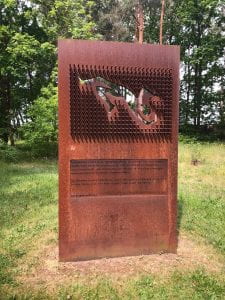Our tours through Berlin have been an enlightening undertaking and are a fitting end to our tour of Europe and study of World War II. Much of what we’ve studied thus far has been focused on military aspects of the war, from the Cabinet War Rooms in London to the D-Day beaches of Normandy and the Battle of the Bulge in Bastogne. We’ve spent much of our time in Europe tracking the Allied advance and learning about their most important events. It’s only fitting we end in Berlin then, where World War II started with Hitler’s rise to power. But instead of remembering the war for its military matters, Germany contends with a much darker history and a facet of the war they can never forget – the Holocaust. But to give the modern state credit, Germany offers a wide array of tours through museums and other historical sites to teach the people what transpired in the Nazi era.
We toured a great many sites, and all of them were deeply impactful in their own right, but the one that stays foremost in my mind was the German Resistance Museum. Other sites rightly focused on how the Holocaust happened and what it meant for the thirteen million lives that it extinguished, and I would argue that they are a prerequisite to view the Resistance Museum. It is almost impossible to convey the dread seen at sites like the Sachsenhausen Concentration Camp, but thoughts and feelings linger with you. Understanding and coming to terms with the scope of the industrial slaughter that Nazi Germany wrought instills a deep-seated dread and revulsion that sticks to the soul like tar. But it’s necessary that we tour these sights and try to understand how and why it happened. But the reason I look back at the resistance museum with such a keen memory was its profound story of hope. The feelings and thoughts contained within the museum manifested as a small flicker of light within the vast darkness of the Holocaust’s history.

A wreath and plaque commemorating Claus von Stauffenberg who attempted, and failed, to assassinate Adolf Hitler on July 20, 1944. He was executed in the courtyard where this wreath is laid.
We learned from a fellow student that German resistance was fated to be a footnote in history of the Third Reich. A resistance that never was, actions against the German state were small, contained, and rather ineffective as a whole against the sheer weight of indoctrination and machinations of a totalitarian state. Many stood on the sidelines as a matter of self-preservation, apathetic to the suffering of their fellow humans, but the Resistance Museum is dedicated to those who fought back in whatever manner they could. Walking through the exhibits and reading the individual stories was almost invigorating in a sense. The tar-like dread that covered one’s soul felt a small bit lighter after reading these people’s exploits and just how many lives they saved doing so.
Almost all of their stories ended in tragedy, though. Few escaped the wrath of the Gestapo, and the debilitating fear of their reprisals frightened most Germans into apathy or compliance. I have generally softened my heart to those who remain on the sidelines in revolutionary conflicts, but cooperation with the Nazi regime is an omnipresent demon that the German people must contend with. I only pray I am never put I such a situation like that.
We also learned a great deal about how the German people remember and commemorate the war in the face of such a dark history. It’s understandable that the resistance museum has become a beacon of commemoration, even bringing the nation’s Prime Minister in a yearly ceremony to remember the men that tried to assassinate Adolf Hitler in July 1944. We won’t be here to see the event take place, but it does bring some amount of comfort that the German people still keep the events of the Second World War in their hearts and minds as they look towards the future.

An interpretive statue in the same courtyard as the wreath. The statue’s nudity and tied hands can be interpreted as laying oneself bare before God before execution.
It has been a reckoning of the soul to experience the history of the Holocaust in Berlin, but I am grateful to the very core of my being that I had the opportunity to learn, first-hand, all that I have from this study abroad. My deepest and most heartfelt thanks go out to every person who gave me this opportunity to study abroad in Europe. I hope you all carry some small measure of pride in creating this opportunity of learning and enlightenment for us on this tour.

























